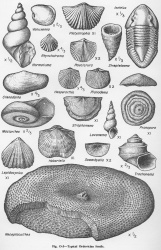Kings Lake Formation
Lithostratigraphy: Ottawa Limestone Megagroup >>Galena Group >>Decorah Subgroup >>Kings Lake Formation
Chronostratigraphy: Paleozoic Erathem >>Ordovician System >>Champlainian Series >>Trentonian Stage
Allostratigraphy: Tippecanoe Sequence
Primary source
Willman, H. B., Elwood Atherton, T. C. Buschbach, Charles Collinson, John C. Frye, M. E. Hopkins, Jerry A. Lineback, and Jack A. Simon, 1975, Handbook of Illinois Stratigraphy: Illinois State Geological Survey Bulletin 95, 261 p.
Contributing author(s)
H. B. Willman and T. C. Buschbach
Name
Original description
Kings Lake Formation (Herbert, 1949; Templeton and Willman, 1963, p. 110).
Derivation
The Kings Lake Formation is named for Kings Lake, a village in Lincoln County, Missouri, a mile east of the type section.
Other names
History/background
Type section
Type location
The type section of the Kings Lake Formation is located in the Mississippi River bluffs (SE SE NE 26, 50N-2E), where it is 9.2 feet thick.
Type author(s)
Type status
Reference section
Reference location
Reference author(s)
Reference status
Stratigraphic relationships
The Kings Lake Formation overlies the Spechts Ferry Formation, underlies the Guttenberg Formation, and is conformable with both.
Extent and thickness
The Kings Lake Formation is exposed in Illinois only near West Point Landing in Calhoun County, but it is widely exposed in eastern Missouri. It is locally missing on the flanks of the Ozarks, where it is overlapped by the Dunleith Formation. It is commonly 5-10 feet thick but is locally as much as 15 feet thick. It thins out northward and does not extend to the northern outcrop area of the Decorah.
Lithology
The Kings Lake Formation consists largely of argillaceous, very silty, dolomitic limestone with a few thin beds of shale, calcarenite, and bentonite. It locally contains fine sand. It is subdivided into two members. The Mincke Member, at the base, contains more shale and calcarenite than the overlying Tyson Member. Many of the characteristics of the Kings Lake are transitional from those of the Spechts Ferry to those of the Guttenberg, but the Kings Lake is more silty and sandy than either of them.
Core(s)
Photograph(s)
Contacts
Well log characteristics
Fossils
The Kings Lake Formation contains a mixture of Spechts Ferry and Guttenberg fossils- the most abundant being Pionodema subaequata, Zygospira recurvirostris , and locally Sowerbyella curdsvillensis (fig. O-5).
Age and correlation
Strata lithologically similar to the Kings Lake appear to be missing in the New York section but are widely present in Kentucky in the lower part of the Logana Formation and in Tennessee in the Hermitage Formation.
Environments of deposition
Economic importance
Remarks
References
HERBERT, PAUL, JR., 1949, Stratigraphy of the Decorah Formation in western Illinois: University of Chicago Ph.D. thesis; Illinois State Geological Survey manuscript PH-1.
TEMPLETON, J. S., and H. B. WILLMAN, 1963, Champlainian Series (Middle Ordovician) in Illinois: Illinois State Geological Survey Bulletin 89, 260 p.
ISGS Codes
| Stratigraphic Code | Geo Unit Designation |
|---|---|
